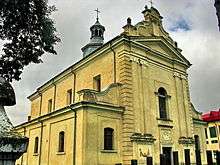Kopychyntsi
| Kopychyntsi Копичинці | ||
|---|---|---|
|
Church of Exaltation of the Holy Cross | ||
| ||
 Kopychyntsi Map of Ukraine with Kopychyntsi highlighted. | ||
| Coordinates: 49°06′29″N 25°54′46″E / 49.10806°N 25.91278°ECoordinates: 49°06′29″N 25°54′46″E / 49.10806°N 25.91278°E | ||
| Country |
| |
| Oblast |
| |
| Raion | Husiatyn Raion | |
| First mention | 1443 | |
| Magdeburg Rights | 1564 | |
| Population (2001 census) | ||
| • Total | 7,036 | |
| Time zone | EET (UTC+2) | |
| • Summer (DST) | EEST (UTC+3) | |
| Postal code | 48260 | |
| Area code(s) | +380 3557 | |


Kopychyntsi (Ukrainian: Копичинці, Polish: Kopyczyńce) is a small city in Husiatyn Raion, Ternopil Oblast, Ukraine. It has a population of 7,036 (census 2001). It is the birthplace of Ukrainian chess grandmaster Vassily Ivanchuk, Israel Jacob Kligler, who led the effort of eradicating malaria in Mandatory Palestine, and Israeli politician Pinhas Lavon.
History
The city was first mentioned in 1340 as a village in the povit of Terebovlia. With time it grew to become a town within the Land of Halicz, itself part of Podole Voivodeship of Poland and then the Polish-Lithuanian Commonwealth. It was granted a city charter in 1564. In late 1648, during the Khmelnytsky Uprising, a combined Cossack and Tartar army under Asand Demko seized the town. However, following the Battle of Kopychyntsi of May 12, 1651, in which the enemy forces were defeated by hetman Marcin Kalinowski, it returned to Poland.
In the effect of the Treaty of Buchach of 1672 the town was ceded to Ottoman Empire, but it returned to Poland after the Treaty of Karlowitz of 1699. Following the Partitions of Poland it became part of Austrian Empire and was then seized by Napoleon Bonaparte who gave it to Russian Empire in the Treaty of Tilsit of 1807. Russian control however ended with the Congress of Vienna which awarded the area back to Austria. It shared the history of the surrounding lands of the Kingdom of Galicia and Lodomeria for the rest of the 19th century.
Following World War I the area was disputed between Poland and the West Ukrainian People's Republic (ZUNR) in what became known as the Polish-Ukrainian War. In June 1919, during the Chortkiv offensive, the 1st Galician Corps of the ZUNR under Osyp Mykytka seized the town, but it was retaken by Polish forces under Józef Haller the following month. Following the Treaty of Riga the town was officially restored to Poland. It was made a seat of a separate powiat within Tarnopol Voivodeship and a garrison town of a Border Protection Corps battalion Kopyczyńce.
Following the September Campaign of 1939 and the outbreak of World War II, the town was occupied first by the Soviet Union and then Nazi Germany. According to the Soviet Extraordinary Commission, approximately 8,000 Jews were killed in Kopychyntsi during the war.[1] After the war it was annexed by the USSR, and since 1991 is part of independent Ukraine.
Religion
Houses of worship
- Ukrainian Greek Catholic Church of the Exaltation of the Holy Cross and bell tower (1630), located at Kutets
- Church of St. Nicholas on the Mount (1900), architect Vasyl Nahirny
- Roman Catholic Church of the Assumption of Mary (1802) in the center of the town
- Synagogue
Attractions
- People's House, Kopychyntsi
- Park near the pool, founded in the 18th century;
- Castle (lost).
People from Kopychyntsi
- Vasyl Ivanchuk, Ukrainian chess grandmaster
- Israel Jacob Kligler, Israeli microbiologist
- Mefodiy (Kudriakov)
- Adam Obrubański, Polish actor
- Roman Hubczenko, Polish actor
- Franciszek Slawski, Polish linguist
- Pinhas Lavon, Israeli politician best known for the Lavon Affair
People associated with Kopychyntsi
References
- ↑ "Yahad-In Unum Interactive Map". Execution Sites of Jewish Victims Investigated by Yahad-In Unum. Retrieved 11 February 2015.
External links
| Wikimedia Commons has media related to Kopychyntsi. |
- (in Ukrainian) Сайт Копичинців
- (in Polish) Kopeczyńce in the Geographical Dictionary of the Kingdom of Poland, volume IV (Kęs — Kutno) published 1883
.
